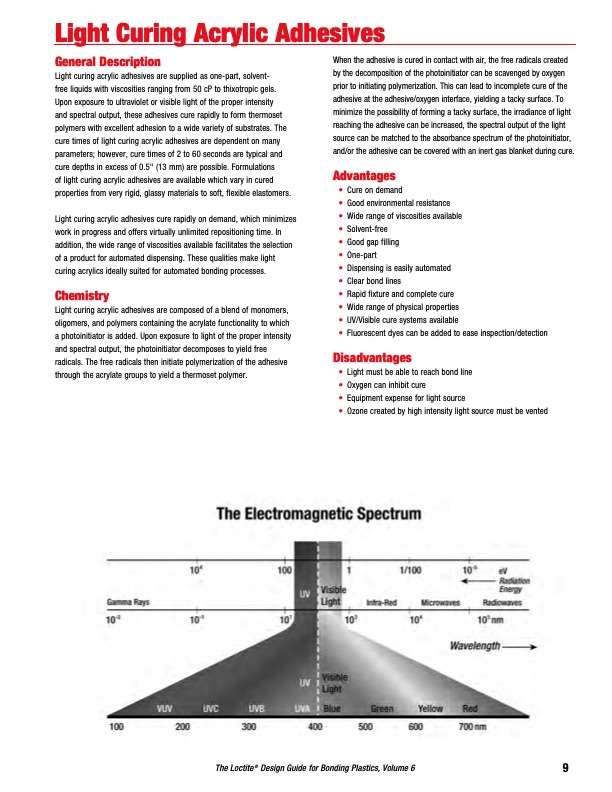
PDF Publication Title:
Text from PDF Page: 011
Light Curing Acrylic Adhesives General Description Light curing acrylic adhesives are supplied as one-part, solvent- free liquids with viscosities ranging from 50 cP to thixotropic gels. Upon exposure to ultraviolet or visible light of the proper intensity and spectral output, these adhesives cure rapidly to form thermoset polymers with excellent adhesion to a wide variety of substrates. The cure times of light curing acrylic adhesives are dependent on many parameters; however, cure times of 2 to 60 seconds are typical and cure depths in excess of 0.5" (13 mm) are possible. Formulations of light curing acrylic adhesives are available which vary in cured properties from very rigid, glassy materials to soft, flexible elastomers. Light curing acrylic adhesives cure rapidly on demand, which minimizes work in progress and offers virtually unlimited repositioning time. In addition, the wide range of viscosities available facilitates the selection of a product for automated dispensing. These qualities make light curing acrylics ideally suited for automated bonding processes. Chemistry Light curing acrylic adhesives are composed of a blend of monomers, oligomers, and polymers containing the acrylate functionality to which a photoinitiator is added. Upon exposure to light of the proper intensity and spectral output, the photoinitiator decomposes to yield free radicals. The free radicals then initiate polymerization of the adhesive through the acrylate groups to yield a thermoset polymer. When the adhesive is cured in contact with air, the free radicals created by the decomposition of the photoinitiator can be scavenged by oxygen prior to initiating polymerization. This can lead to incomplete cure of the adhesive at the adhesive/oxygen interface, yielding a tacky surface. To minimize the possibility of forming a tacky surface, the irradiance of light reaching the adhesive can be increased, the spectral output of the light source can be matched to the absorbance spectrum of the photoinitiator, and/or the adhesive can be covered with an inert gas blanket during cure. Advantages • Cure on demand • Good environmental resistance • Wide range of viscosities available • Solvent-free • Good gap filling • One-part • Dispensing is easily automated • Clear bond lines • Rapid fixture and complete cure • Wide range of physical properties • UV/Visible cure systems available • Fluorescent dyes can be added to ease inspection/detection Disadvantages • Light must be able to reach bond line • Oxygen can inhibit cure • Equipment expense for light source • Ozone created by high intensity light source must be vented The Loctite® Design Guide for Bonding Plastics, Volume 6 9PDF Image | Design Guide for Bonding Plastics Volume 6 LT-2197

PDF Search Title:
Design Guide for Bonding Plastics Volume 6 LT-2197Original File Name Searched:
henkel-loctite-design-guide-plastic-bonding.pdfDIY PDF Search: Google It | Yahoo | Bing
Development of a solar powered Electric Ship The Electricship website originally started off as a project to develop a comprehensive renewable, affordable, modular electric ship... More Info
Modular Boat Hull Composite The case for a unsinkable, modular composite hybrid boat hull... More Info
MS Burgenstock Hybrid Electric Catamaran Lake Lucerne Unique shuttle servicing Lucerne to the Burgenstock Resort... More Info
Ground Power Unit GPU Powered by Lithium Ion Batteries The goal of the Ground Power Unit is to provide a readily accessible, modular, ready-to-power solution for remote power... More Info
| CONTACT TEL: 608-238-6001 Email: greg@electricship.com | RSS | AMP |